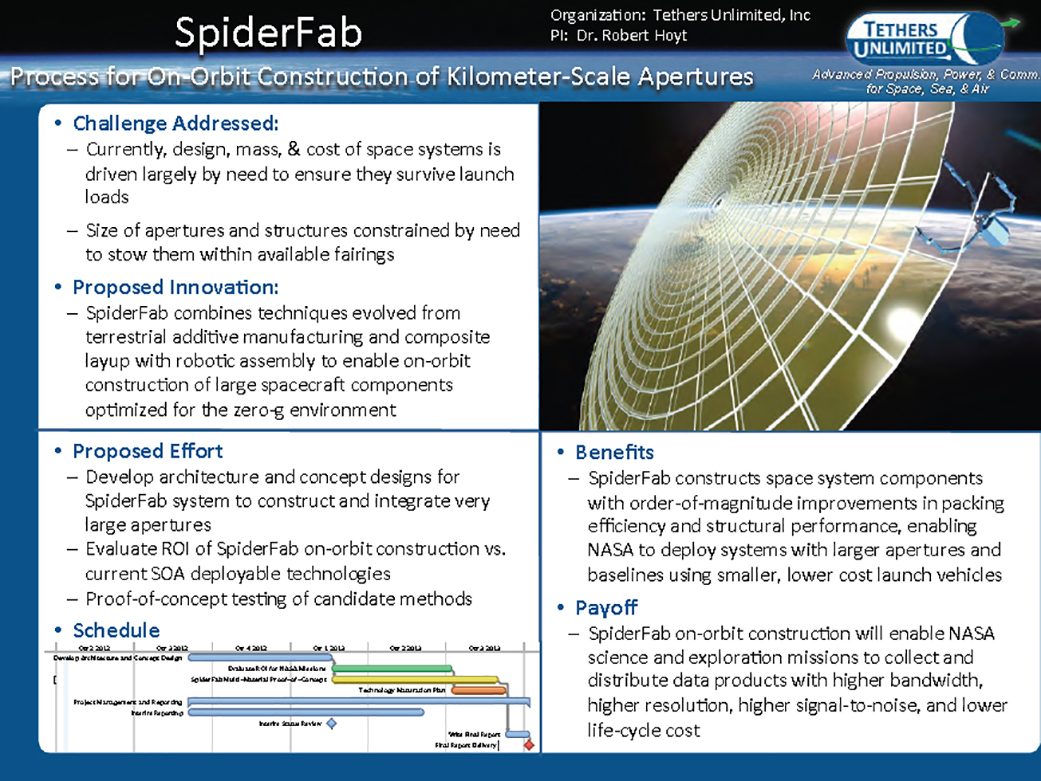Robert Hoyt
Tethers Unlimited, Inc.
NIAC 2012 Phase I Hoyt SpiderFab Final Report
Currently, a significant fraction of the engineering cost and launch mass of space systems is required exclusively to enable the system to survive launch. This is particularly true for systems with physically large components, such as antennas, booms, and panels, which must be designed to stow for launch and then reliably deploy on orbit. Furthermore, the sizes of apertures and spacecraft structures are limited by the requirement to stow them within available launch fairings. Deployable structures and inflatable/rigidizable components have enabled construction of systems with scales of several dozen meters, but their packing efficiency is not sufficient to enable scaling to the kilometer-size baselines desired for applications such as long-baseline interferometry and sparse aperture sensing.
We propose to develop a process for automated on-orbit construction of very large structures and multifunctional components. The foundation of this process is a novel additive manufacturing technique called ‘SpiderFab’, which combines the techniques of fused deposition modeling (FDM) with methods derived from automated composite layup to enable rapid construction of very large, very high-strength-per-mass, lattice-like structures combining both compressive and tensile elements. This technique can integrate both high-strength structural materials and conducting materials to enable construction of multifunctional space system components such as antennas. The SpiderFab technique enables the constituent materials for a space structure to be launched in an extremely compact form, approaching perfect packing efficiencies, and processed on-orbit to form structures optimized for the micro-gee space environment, rather than launch environments. The method can also create structures with 2nd and higher orders of hierarchy, such as a ‘truss-of-trusses’, achieving 30X mass reductions over the 1st order hierarchy structures used in most space applications. This approach can therefore enable deployment of antenna reflectors, phased array antennas, solar panels, and radiators with characteristic sizes one to two orders of magnitude larger than current state-of-the-art deployable-structure technologies can fit within available launch shrouds.
The SpiderFab process for on-orbit construction of large, lightweight structures will dramatically reduce the launch mass and stowed volume of NASA systems for astronomy, Earth-observation, and other missions requiring large apertures or large baselines, enabling them to be deployed using much smaller, less expensive launch vehicles and thereby reducing total life cycle cost for these missions. Potential applications include construction of multiple high-gain antennas in Earth and solar orbit to support a deep-space communications network, long-baseline interferometry systems for terrestrial planet finder programs, and submillimeter astronomy of cosmic structure. The proposed space system fabrication technologies will also enable these systems to be re-configurable and repairable on orbit, and can evolve to support ISRU of orbital debris in Earth orbit and asteroid materials in deep space exploration missions.
In the proposed effort, we will develop concept designs for space systems that will use the SpiderFab process to create and integrate very large apertures and other structures for NASA space science and exploration missions. We will develop an architecture concept combining the SpiderFab process with robotic assembly technologies and automated quality control/metrology techniques to enable on-orbit construction of kilometer-scale antenna apertures to enable capabilities such as high-bandwidth communications with deep-space probes and radar imaging of deep-space objects. We will then evaluate the potential performance benefits for candidate missions relative to state-of-the-art deployables technologies.































